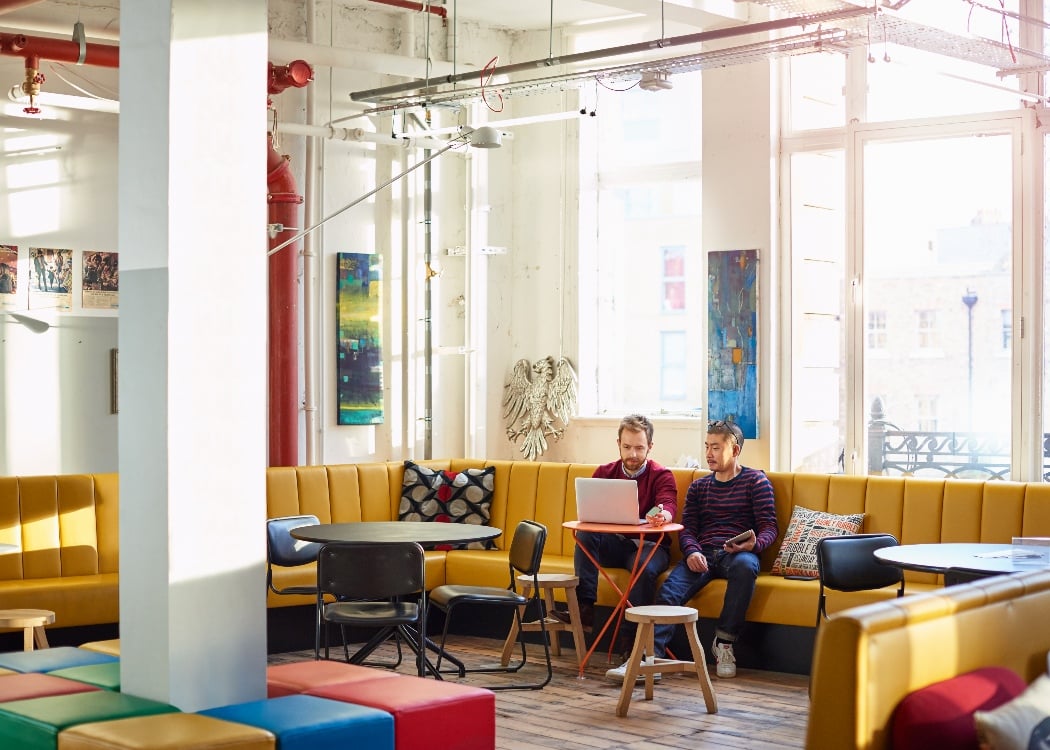
Let us help you with finding an office space
Our experts are here to help take the hard work out of finding your next office space.

A committed, motivated team of employees is essential to scaling up a business, and retaining these workers creates an opportunity for the company to reach full operational capacity. This is especially important in a reimagined work landscape brought on by a global pandemic.
Constantly changing internal policies - coupled with business model alterations during lockdown - has led to many people starting the job hunt again. Some workers simply want more familiar, “normal” work in a physical office space again, others have been mandated to be in the office on certain days and miss the flexibility to work from home.
This rise in jobseekers brings a bigger focus on retaining top talent and continuing on a growth path. The right office space in a good location can work wonders as a part of a strategy to consistently retain top talent. This guide details why this is the case, along with covering the basics around measuring and improving employee retention within an organisation.
Employee retention refers to how well an organisation keeps its existing employees. But it covers more than just keeping track of the people who leave the company, those who replace them and others who stay in their positions over a longer period.
It also extends to broader staff management, office design, training and development, benefits, ongoing communication around employment law, job satisfaction and, ultimately, whether people are keen to continue working for the company.
Employee retention can be tracked as a specific metric, but some companies still blind hire without considering wider implications. Without a firm strategy in place, you run the risk of overhiring and, while you can always ‘right size’ your business against its office space with Knight Frank, it can pose operational and logistic issues.
While aspects like continuing professional development (CPD) and company benefits have their part to play in retaining employees, you can’t ignore how powerful having the right office can be. Your office is likely the first impression of what a real working day will be like for any potential candidates, especially if you’re interviewing in-person rather than remotely.
But what happens once the interview process is over and the position has been filled? The office then becomes the setting for most of their days, so it’s important you create a comfortable and productive environment for your employees. Various factors contribute to the atmosphere and feeling of your office, including:
Your office naturally provides the opportunity to get people socialising again after the pandemic, which works to boost employee relationships and can improve the mental wellbeing of individual team members.
Allow your office space to showcase company culture, and encourage your employees to have a say in what they’d like to see in the space. Whether that’s with artwork, furniture or even the layout, it’s important that your team feel comfortable at work.

A well thought out employee retention strategy is significant as it allows businesses to hire the best skills while also keeping these workers motivated in their roles too. This strategy should cover upskilling opportunities, career progression timelines and even just a basic policy for recognising successful projects or campaigns when these are completed.
The strategy should also cover how the physical office space can boost job satisfaction levels. Being located near major transport links, for instance, will potentially save employees on travel time and costs. A well-positioned building with a lot of natural sunlight will encourage a cosy work environment. Having coffee shops and restaurants in the vicinity encourages social interaction (and offers different options for meetings), fostering bonds between staff members outside of the traditional office environment.
Well-positioned office real estate matters more than ever as we are living in a historical period characterised by high staff turnover rates. Ushered in by the COVID-19 pandemic, the so-called age of the “Great Resignation” is partly due to lockdowns and home working instructions, giving many people an opportunity to stop to reflect on their lives and where work falls into their broader goals.
With the pandemic came reminders of how fast life moves, which caused many people to shift their focus to finding a better work-life balance. Retention rates have also been affected by people having to quit their jobs to become caregivers at home, often due to a family member becoming ill. Whatever the reason, this is bad news for any company with a long-term view toward growth.
When a highly-skilled worker leaves a job, two significant things happen. Firstly, they leave a skills void in the company, which often takes a lengthy recruitment process to replace.
Secondly, they enter into a transition period in their new role, which can take up to six months to settle into. Efficiency is affected in both situations, which can be detrimental to any strategy to scale up operations.
The rise of remote working has made it easier for people to leave a job on Friday and start a new one from home on Monday. The same opportunity applies (albeit with somewhat more admin involved) in countries offering digital nomad visas for remote workers to stay in the country consecutively for up to a year.
If not carefully managed, fully remote working can generate an influx of resignations of highly skilled workers. For this reason, businesses must account for and factor this into their employer retention strategies.
We can help you find the best office space based on the needs of your team if you’re thinking about an upgrade.
Although a moderate level of staff turnover can be healthy in the process of scaling a business, extremes should be avoided at all costs.
Finding the right balance means doing what’s possible to retain the best talent. Prioritising employee retention can lead to the following benefits:
A thorough employee retention strategy should include measuring it as a tangible metric that can be compared from one period to the next. Doing so presents an opportunity for leaders (and HR teams) to set targets, monitor and compare different periods and spot resignation trends.
The employee stability index is a well-known staff retention rate metric. It offers a look into the number of experienced employees in the business relative to the team’s newer members. It makes it possible to measure how experienced employees are being retained over the course of 12 months through a simple calculation:
Average employee retention rates tend to vary by industry. Calculating this across multiple years creates comparable internal data sets to find an average specific to the business.
The index can also be used for uncovering employee retention rates across specific departments in the organisation. From there, leaders can pinpoint problem areas and take action to improve employee retention as soon as possible.

Over and above doing their best to offer competitive pay packages with sufficient benefits to keep employees happy — as well as finding the perfect office space in the best location — employers can try these specific methods to improve employee retention rates without having to dip into the yearly budget:
Without a great team at the helm, very few businesses are able to reach their goals - or the long-term vision set out by their mission statement. High levels of employee retention are essential for building momentum to eventually scale up operations.
Getting there means always encouraging a productive workplace, starting with getting the fundamentals of where the office is located — as well as how the space meets the needs of the staff — 100% right.
If you’ve decided to rent a new serviced office space with us to get the ball rolling, you’re already well on track to getting there.
In no time at all, your tight-knit team will be taking the business to entirely new heights.
Get your monthly dose of workplace insights, productivity hacks and business leadership ideas - delivered straight to your inbox.

Our experts are here to help take the hard work out of finding your next office space.